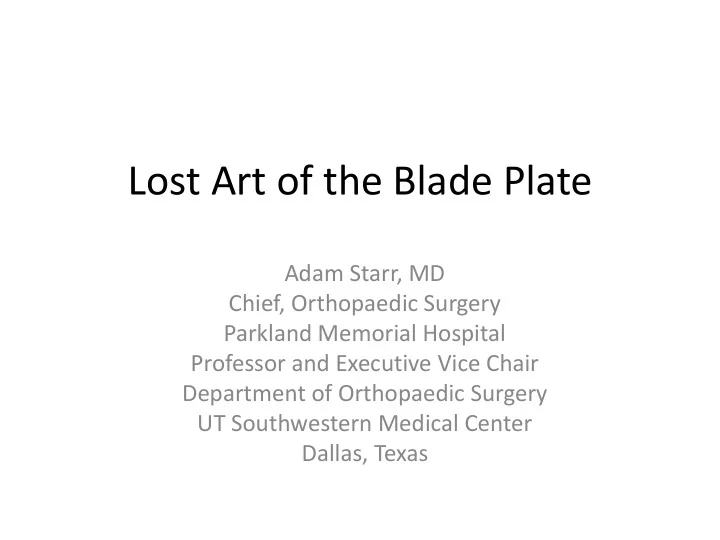

Lost Art of the Blade Plate Adam Starr, MD Chief, Orthopaedic Surgery Parkland Memorial Hospital Professor and Executive Vice Chair Department of Orthopaedic Surgery UT Southwestern Medical Center Dallas, Texas
Blade Plates • An old technique and device. • Technically demanding. • Requires more attention to detail than modern devices.
Primarily Used for Nonunions • Nowadays it’s an option for femoral neck nonunion in young patients. • Also used for supracondylar femur nonunions. • Very rigid, very strong device.
Femoral Neck Nonunion • Almost always used in concert with a valgus intertroch osteotomy, to improve the mechanics of the nonunion angle.
Nutshell
Intertrochanteric osteotomy for non-union of the femoral neck RK Marti, HM Schuller, EL Raaymakers Published 1 November 1989 JBJS Br • We report a series of 50 patients under 70 years of age who had an ununited femoral neck fracture treated by a Pauwels abduction osteotomy. At an average follow-up of 7.1 years, seven patients had required prosthetic replacement and 37 others were reviewed in detail. In these patients the Harris hip score averaged 91. Twenty- two hips showed radiographic evidence of avascular femoral head necrosis, but only three of these had been replaced. For active patients with non-union of a femoral neck fracture, Pauwels osteotomy provides a high proportion of good results even in the presence of avascular necrosis of the head, providing there has been no collapse. If osteotomy fails, prosthetic replacement is still possible.
More typical…
What’s so hard about it? (Thanks to AO Foundation!) 95’ or 130’ (usually 130 for neck Ideal position nonunion)
Tools
Plan
Execution
Femoral Neck Nonunion never looks quite as clean…
But It Works! Intertrochanteric Osteotomy for Failed Internal Fixation of Femoral Neck Fracture. Anglen, Jeffrey O. MD Clinical Orthopaedics & Related Research: August 1997 Thirteen patients with failed internal fixation of the femoral neck were • treated with valgus intertrochanteric osteotomy performed by one surgeon from 1987 to 1995. The patients ranged in age from 18 to 59 years. The interval from injury to osteotomy ranged from 4 to 54 weeks. With an average followup of 25 months (range, 9-42 months), the femoral neck fracture healed in all patients. Twelve patients returned to being fully weightbearing without pain. The average limb shortening was improved by 1 cm. Seven of eight patients who were employed before their injuries returned to the same occupations. Femoral head collapse because of avascular necrosis developed in one patient 18 months after surgery and return to full activities and in a second patient shortly after the osteotomy. These two patients now have an arthroplasty. The remainder of the patients have done well without requiring additional surgery. Harris hip scores and Short Form 36 Health Status Survey outcome scoring were available to verify the results in 10 patients.
Tips Seating the chisel Gear • Perfect placement is crucial • I use a fracture table, supine • Low in the head • Make sure you can see the femoral neck on a lateral • Rotationally perfect view. • IT osteotomy at the top of the lesser troch.
Thank You
Recommend
More recommend